
Concept explainers
Draw the organic products formed in each reaction.
a.![Chapter 23, Problem 23.52P, Draw the organic products formed in each reaction. a.f. b.g. c. CH3CH2CH2CO2Et[2]CH3CH2I[1]LDAh. , example 1](http://dev-ingestion-image-output.s3-website-us-east-1.amazonaws.com/9780073402772/Chapter-23/images/02772-23-23.52p-question-digital_image001.jpg) f.
f.![Chapter 23, Problem 23.52P, Draw the organic products formed in each reaction. a.f. b.g. c. CH3CH2CH2CO2Et[2]CH3CH2I[1]LDAh. , example 2](http://dev-ingestion-image-output.s3-website-us-east-1.amazonaws.com/9780073402772/Chapter-23/images/02772-23-23.52p-question-digital_image002.jpg)
b.![Chapter 23, Problem 23.52P, Draw the organic products formed in each reaction. a.f. b.g. c. CH3CH2CH2CO2Et[2]CH3CH2I[1]LDAh. , example 3](http://dev-ingestion-image-output.s3-website-us-east-1.amazonaws.com/9780073402772/Chapter-23/images/02772-23-23.52p-question-digital_image003.jpg) g.
g.![Chapter 23, Problem 23.52P, Draw the organic products formed in each reaction. a.f. b.g. c. CH3CH2CH2CO2Et[2]CH3CH2I[1]LDAh. , example 4](http://dev-ingestion-image-output.s3-website-us-east-1.amazonaws.com/9780073402772/Chapter-23/images/02772-23-23.52p-question-digital_image004.jpg)
c.
![]()
d.![Chapter 23, Problem 23.52P, Draw the organic products formed in each reaction. a.f. b.g. c. CH3CH2CH2CO2Et[2]CH3CH2I[1]LDAh. , example 6](http://dev-ingestion-image-output.s3-website-us-east-1.amazonaws.com/9780073402772/Chapter-23/images/02772-23-23.52p-question-digital_image006.jpg) i.
i. ![Chapter 23, Problem 23.52P, Draw the organic products formed in each reaction. a.f. b.g. c. CH3CH2CH2CO2Et[2]CH3CH2I[1]LDAh. , example 7](http://dev-ingestion-image-output.s3-website-us-east-1.amazonaws.com/9780073402772/Chapter-23/images/02772-23-23.52p-question-digital_image007.jpg)
e. ![Chapter 23, Problem 23.52P, Draw the organic products formed in each reaction. a.f. b.g. c. CH3CH2CH2CO2Et[2]CH3CH2I[1]LDAh. , example 8](http://dev-ingestion-image-output.s3-website-us-east-1.amazonaws.com/9780073402772/Chapter-23/images/02772-23-23.52p-question-digital_image008.jpg) j.
j.![Chapter 23, Problem 23.52P, Draw the organic products formed in each reaction. a.f. b.g. c. CH3CH2CH2CO2Et[2]CH3CH2I[1]LDAh. , example 9](http://dev-ingestion-image-output.s3-website-us-east-1.amazonaws.com/9780073402772/Chapter-23/images/02772-23-23.52p-question-digital_image009.jpg)
(a)
Interpretation: The organic products formed in given reaction are to be drawn.
Concept introduction: The various organic reactions form different organic products with the help of the variety of reagents. Some of the organic compounds are formed by the characteristic action of the various functional groups present in them.
Answer to Problem 23.52P
The organic product formed in given reaction is,
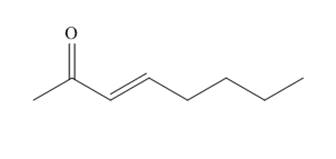
Explanation of Solution
The organic product formed in given reaction is shown below.

Figure 1
The above reaction takes place between a brominated compound and
The organic product formed in given reaction is shown in Figure 1.
(b)
Interpretation: The organic products formed in given reaction are to be drawn.
Concept introduction: The various organic reactions form different organic products with the help of the variety of reagents. Some of the organic compounds are formed by the characteristic action of the various functional groups present in them.
Answer to Problem 23.52P
The organic product formed in given reaction is,
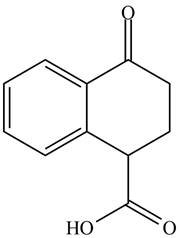
Explanation of Solution
Decarboxylation occurs when a carboxyl group is attached to alpha carbon of another carbonyl group. It removes the carboxylic group from the alpha carbon of the carbonyl group. The corresponding chemical reaction is shown below.

Figure 2
Hence, the organic product formed in given reaction is
The organic product formed in given reaction is shown in Figure 2.
(c)
Interpretation: The organic products formed in given reaction are to be drawn.
Concept introduction: Lithium diisopropylamide (LDA) is a sterically hindered strong base. In an unsymmetrical ketone, it abstracts hydrogen from least substituted carbon to form kinetic product.
Answer to Problem 23.52P
The organic product formed in given reaction is,
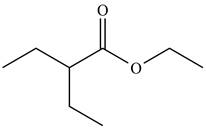
Explanation of Solution
LDA abstracts a proton from the alpha carbon of ethylbutanoate to form enolate. This enolate ion acts as a nucleophile and attacks on electrophilic centre of iodoethane and forms

Figure 3
Hence, the organic product formed in given reaction is
The organic product formed in given reaction is shown in Figure 3.
(d)
Interpretation: The organic products formed in given reaction are to be drawn.
Concept introduction: Alkyl amines are formed by the reaction of alkyl halides with amines. This reaction is known as alkylation of amines.
Answer to Problem 23.52P
The organic product formed in given reaction is,
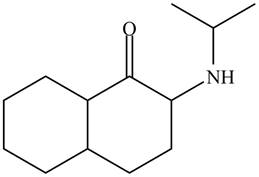
Explanation of Solution
In the first step,

Figure 4
Hence, the organic product formed in given reaction is
The organic product formed in given reaction is shown in Figure 4.
(e)
Interpretation: The organic products formed in given reaction are to be drawn.
Concept introduction: Lithium diisopropylamide (LDA) is a sterically hindered strong base. In an unsymmetrical ketone, it abstracts hydrogen from least substituted carbon to form kinetic product.
Answer to Problem 23.52P
The organic product formed in given reaction is,
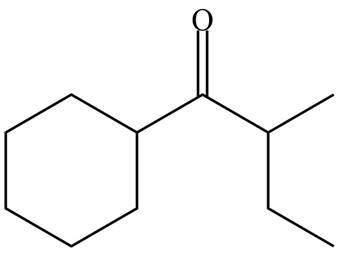
Explanation of Solution
LDA abstracts a proton from the less hindered alpha carbon of

Figure 5
Hence, the organic product formed in given reaction is
The organic product formed in given reaction is shown in Figure 5.
(f)
Interpretation: The organic products formed in given reaction are to be drawn.
Concept introduction: Monobromo product is formed by the reaction of carbonyl compounds with bromine in the presence of acetic acid and further treatment of monobromo with base yield alkenes.
Answer to Problem 23.52P
The organic product formed in given reaction is,

Explanation of Solution
Monobromo product is formed by the reaction of

Figure 6
Hence, the organic product formed in given reaction is
The organic product formed in given reaction is shown in Figure 6.
(g)
Interpretation: The organic products formed in given reaction are to be drawn.
Concept introduction: Haloform is produced by the halogenation of a methyl ketone in the presence of a base. This reaction is also known as haloform reaction.
Answer to Problem 23.52P
The organic product formed in given reaction is,
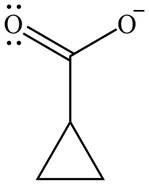
Explanation of Solution
The enolate ion reacts with iodine and form

Figure 7
The organic product formed in given reaction is shown in Figure 7.
(h)
Interpretation: The organic products formed in given reaction are to be drawn.
Concept introduction: Sodium hydride is a strong base. It abstracts a proton and forms carbanion. This carbanion acts as a nucleophile and attacks on the electrophilic centre of alkyl halide.
Answer to Problem 23.52P
The organic product formed in given reaction is,
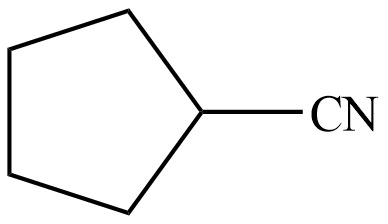
Explanation of Solution
Sodium hydride abstracts a proton from the carbon which is attached to cyanide and forms secondary carbanion. The next step is intra molecular cyclization. Now this carbanion acts as nucleophile and attack to the carbon (electrophile) which is directly attach to the electronegative atom i.e. chlorine. The corresponding chemical reaction of given organic compound with a strong base is shown below

Figure 8
Hence, the organic product formed in given reaction is cyclopentanecarbonitrile.
The organic product formed in given reaction is shown in Figure 8.
(i)
Interpretation: The organic products formed in given reaction are to be drawn.
Concept introduction: Bromination is a type of radical substitution reaction. It is highly specific reaction. In this reaction, an alkyl halide is formed by the replacement of hydrogen atom from highly substituted carbon by
Answer to Problem 23.52P
The organic product formed in given reaction is,
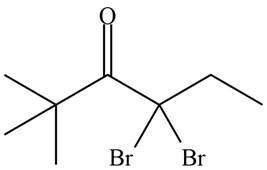
Explanation of Solution
An alkyl halide is formed by the replacement of hydrogen atom from highly substituted carbon by

Figure 9
Hence, the organic product formed in given reaction is
The organic product formed in given reaction is shown in Figure 9.
(j)
Interpretation: The organic products formed in given reaction are to be drawn.
Concept introduction: The various organic reactions form different organic products with the help of the variety of reagents. Some of the organic compounds are formed by the characteristic action of the various functional groups present in them.
Answer to Problem 23.52P
The organic product formed in the given reaction is,

Explanation of Solution
The organic product formed in the given reaction is shown below.
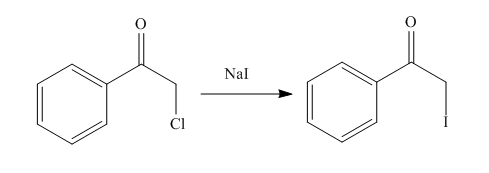
Figure 10
In the above reaction, chlorinated compound reacts with sodium iodide that results in the replacement of chlorine atom by iodine atom.
The organic product formed in given reaction is shown in Figure 10.
Want to see more full solutions like this?
Chapter 23 Solutions
Organic Chemistry-Package(Custom)
- Epoxides can be opened in aqueous acid or aqueous base to produce diols (molecules with two OH groups). In this question, you'll explore the mechanism of epoxide opening in aqueous acid. 2nd attempt Be sure to show all four bonds at stereocenters using hash and wedge lines. 0 0 Draw curved arrows to show how the epoxide reacts with hydronium ion. 100 +1: 1st attempt Feedback Be sure to show all four bonds at stereocenters using hash and wedge lines. See Periodic Table See Hint H A 5 F F Hr See Periodic Table See Hintarrow_forward03 Question (1 point) For the reaction below, draw both of the major organic products. Be sure to consider stereochemistry. > 1. CH₂CH₂MgBr 2. H₂O 3rd attempt Draw all four bonds at chiral centers. Draw all stereoisomers formed. Draw the structures here. e 130 AN H See Periodic Table See Hint P C Brarrow_forwardYou may wish to address the following issues in your response if they are pertinent to the reaction(s) you propose to employ:1) Chemoselectivity (why this functional group and not another?) 2) Regioselectivity (why here and not there?) 3) Stereoselectivity (why this stereoisomer?) 4) Changes in oxidation state. Please make it in detail and draw it out too in what step what happens. Thank you for helping me!arrow_forward
- 1) Chemoselectivity (why this functional group and not another?) 2) Regioselectivity (why here and not there?) 3) Stereoselectivity (why this stereoisomer?) 4) Changes in oxidation state. Everything in detail and draw out and write it.arrow_forwardCalculating the pH at equivalence of a titration 3/5 Izabella A chemist titrates 120.0 mL of a 0.7191M dimethylamine ((CH3)2NH) solution with 0.5501 M HBr solution at 25 °C. Calculate the pH at equivalence. The pk of dimethylamine is 3.27. Round your answer to 2 decimal places. Note for advanced students: you may assume the total volume of the solution equals the initial volume plus the volume of HBr solution added. pH = ☐ ✓ 18 Ar Boarrow_forwardAlcohols can be synthesized using an acid-catalyzed hydration of an alkene. An alkene is combined with aqueous acid (e.. sulfuric acid in water). The reaction mechanism typically involves a carbocation intermediate. > 3rd attempt 3343 10 8 Draw arrows to show the reaction between the alkene and hydronium ion. that 2nd attempt Feedback 1st attempt تعمال Ju See Periodic Table See Hint F D Ju See Periodic Table See Hintarrow_forward
- Draw the simplified curved arrow mechanism for the reaction of acetone and CHgLi to give the major product. 4th attempt Π Draw the simplified curved arrow mechanism T 3rd attempt Feedback Ju See Periodic Table See Hint H -H H -I H F See Periodic Table See Hintarrow_forwardSelect the correct reagent to accomplish the first step of this reaction. Then draw a mechanism on the Grignard reagent using curved arrow notation to show how it is converted to the final product. 4th attempt Part 1 (0.5 point) Select the correct reagent to accomplish the first step of this reaction. Choose one: OA Mg in ethanol (EtOH) OB. 2 Li in THF O C. Li in THF D. Mg in THF O E Mg in H2O Part 2 (0.5 point) Br Part 1 Bri Mg CH B CH, 1 Draw intermediate here, but no arrows. © TE See Periodic Table See Hint See Hint ין Harrow_forwardSelect the product for the following reaction. HO HO PCC OH ○ OH O HO ○ HO HO HOarrow_forward
- 5:45 Х Select the final product for the following reaction sequence. O O 1. Mg. ether 2.D.Oarrow_forwardBased on the chart Two similarities between the molecule with alpha glycosidic linkages. Two similarities between the molecules with beta glycosidtic linkages. Two differences between the alpha and beta glycosidic linkages.arrow_forwardplease help fill in the tablearrow_forward
 Introductory Chemistry: A FoundationChemistryISBN:9781337399425Author:Steven S. Zumdahl, Donald J. DeCostePublisher:Cengage Learning
Introductory Chemistry: A FoundationChemistryISBN:9781337399425Author:Steven S. Zumdahl, Donald J. DeCostePublisher:Cengage Learning Chemistry for Today: General, Organic, and Bioche...ChemistryISBN:9781305960060Author:Spencer L. Seager, Michael R. Slabaugh, Maren S. HansenPublisher:Cengage Learning
Chemistry for Today: General, Organic, and Bioche...ChemistryISBN:9781305960060Author:Spencer L. Seager, Michael R. Slabaugh, Maren S. HansenPublisher:Cengage Learning

